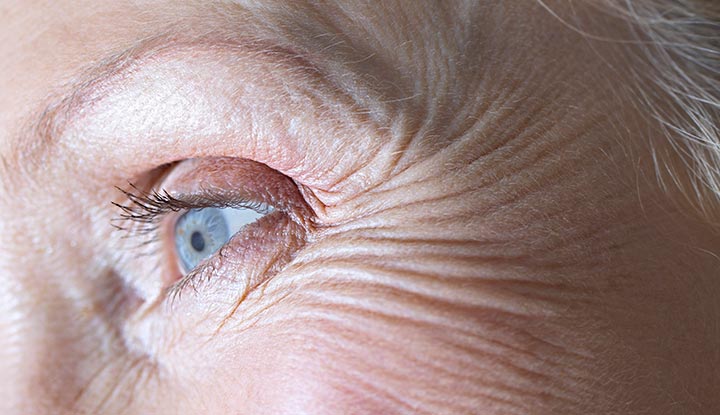Crow’s feet, also known as lateral canthal lines, are fine lines that form on the outer corners of your eyes. If these lines are bothersome to you, there are treatment options available to reduce their appearance.
Advertisement
Cleveland Clinic is a non-profit academic medical center. Advertising on our site helps support our mission. We do not endorse non-Cleveland Clinic products or services. Policy

As you age, you may notice fine lines forming in your skin on the outer corners of your eyes. These are lateral canthal lines, also known as crow’s feet or laugh lines. These small lines and wrinkles form from tiny muscles contracting in the outer corner of your eyes as you experience the many different emotions that influence your facial expressions: laughter, stress, grief and sadness. They usually start out as noticeable lines that form when you smile and your eyes naturally squint. Over time, these fine lines may start to appear on your face when you’re not smiling or even when you’re at rest.
Advertisement
Cleveland Clinic is a non-profit academic medical center. Advertising on our site helps support our mission. We do not endorse non-Cleveland Clinic products or services. Policy
Many other factors play a role in how your skin ages and the development of crow’s feet. Things like sun exposure, whether you use sunscreen, your diet and your genetics are all contributing factors.
Two proteins that help skin retain its plump, youthful appearance — collagen and elastin — naturally decrease as you age. As these proteins wane, you develop fine lines such as frown lines and crow’s feet. Using sunscreen and some facial moisturizers can help prevent crow’s feet from developing. But aging is an inevitable part of life.
Aging affects everyone differently. Researchers have found that crow’s feet tend to appear earlier and form deeper wrinkles in men than in women. Researchers attribute this to several factors, and some are behavioral in nature. For example, researchers theorize that men are less likely to wear sunglasses or use sunscreen than women. But researchers also discovered that men have higher amounts of matrix metalloproteinases, known as MMPs. MMPs are naturally occurring enzymes that break down collagen in your skin. If you have more MMPs, your skin will naturally break down quicker than if you don’t have as many MMPs.
The appearance of crow’s feet might not make your day when you look in the mirror, but they don’t have any ill effects on your body. They aren’t painful and shouldn’t affect you physically. But the appearance of fine lines and wrinkles can make some people feel insecure about their appearance.
Advertisement
If you don’t like the appearance of crow’s feet, it may help to remember that they’re a natural part of aging and most everyone will get them eventually. But you can also consult with your dermatologist (a medical doctor who specializes in skin conditions) about various treatment options that can help reduce the appearance of fine lines and wrinkles.
You may first notice crow’s feet when you’re in your 30s. Depending on your skin care routine and genetics, you may not see them until you’re in your 40s. Prevention is key to slowing the development of crow’s feet and other fine lines.
Collagen and other naturally occurring enzymes in your skin help keep it looking supple and youthful. As you age, however, collagen naturally breaks down from skin. But your lifestyle choices also contribute to how young you’ll develop crow’s feet and how deep your wrinkles will be. Things such as:
See the section below for further ways to prevent and treat crow’s feet.
There are several lifestyle choices you can make to help combat fine lines and wrinkles. But there are also topical creams and tools available over the counter (OTC) that you can apply to your skin to help prevent crow’s feet.
Advertisement
As you age, your crow’s feet might become deeper and more defined. In this case, you may decide to consult with a dermatologist to reduce the appearance of crow’s feet.
Some options for treating crow’s feet that require the help of your dermatologist are:
As with all medications, both over-the-counter treatments and those provided by your healthcare provider come with some risks. You’re more likely to experience side effects from treatments if you have sensitive skin. Some side effects include:
Advertisement
If you find that you’re very troubled by your crow’s feet and they’re affecting your self-esteem, contact your healthcare provider. They can work to find a solution to help minimize the appearance of fine lines and wrinkles and thereby help boost your self-confidence.
As you consider how you’d like to manage your aging skin, you may want to consult with a dermatologist. Here are some questions you might ask:
While you may not like the sight of fine lines and wrinkles around your eyes, aging is a natural part of life and eventually, nearly everyone develops a wrinkle or two. Take solace in knowing your crow’s feet are an indication of the many smiles you’ve experienced in your life. If your crow’s feet affect your self-esteem, see your healthcare provider about Botox or other procedures that can help reduce the appearance of fine lines and wrinkles.
Advertisement
Every day, people see your skin, hair and nails. At Cleveland Clinic, our expert and caring dermatology team will make sure they’re healthy and strong.

Last reviewed on 01/07/2023.
Learn more about the Health Library and our editorial process.